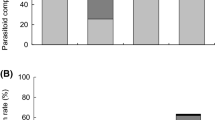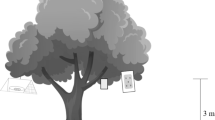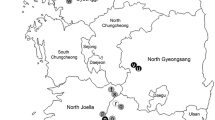Abstract
Controlling the invasive fruit pest, Drosophila suzukii, relies on a range of complimentary pest management approaches. However, increasing external costs (e.g., labour, exclusion mesh and fuel), are limiting the ability to control the pest via non-chemical means. Extant UK parasitoids could be exploited for the suppression of D. suzukii populations, but there is currently a lack of knowledge of the UK species utilising D. suzukii as a host or their lifecycle requirements. Between 2017 and 2020, we identified parasitoids developing in D. suzukii, in Southeast England.
Sentinel traps, containing laboratory reared D. suzukii larvae/pupae in fruit, were deployed within the vicinity of commercial crops and semi-natural areas. Six generalist parasitoid species were recovered from D. suzukii sentinel traps. These included two species of larval parasitoids (Leptopilina heterotoma Thomson (Hymenoptera: Figitidae) and Asobara tabida (Nees) (Hymenoptera: Braconidae) and four pupal parasitoids (Pachycrepoideus vindemiae (Rondani) (Hymenoptera: Pteromalidae), Spalangia erythromera (Forster) (Hymenoptera: Pteromalidae), Trichopria modesta (Ratzeburg, 1848) and T. prema Nixon (both Hymenoptera: Diapriidae)).
The performance of the first four species as D. suzukii parasitoids was further tested in the laboratory and then in the field to assess rates of parasitism. Pachycrepoideus vindemiae was the most abundant species recovered from field collections and had in increasing rate of population rate in the laboratory. Other species were not successful at parasitising D. suzukii. In the field, adult D. suzukii emergence from sentinel traps was reduced by ~ 21% where parasitoids could access D. suzukii larvae and pupae.
Parasitoids of D. suzukii are understudied in the UK, and this research indicates where future efforts could be made in understanding the interaction between host and parasitoid and the opportunities to exploit extant parasitoids for the control of D. suzukii. We also evaluate the prospects for classical and augmented control and discuss how they may fit with current regional integrated pest management options.





Similar content being viewed by others
Data availability
Raw data is provided in the body of the manuscript or in the Figshare repository at https://doi.org/10.6084/m9.figshare.23826675.v1. Please note that location information has been removed due to the sensitivity of disclosing commercial growers’ sites.
References
Abram PK, Wang X, Hueppelsheuser T, Franklin MT, Daane KM, Lee JC, Lue CH, Girod P, Carrillo J, Wong WH, Kula RR (2022) A coordinated sampling and identification methodology for larval parasitoids of spotted-wing Drosophila. J Econ Entomol 115(4):922–942
Alhmedi A, Clymans R, van Kerckvoorde V, Bylemans D, Beliën T (2019) Preference and performance of Drosophila suzukii on Prunus species: a potential eco-friendly pest management tool. Crop Prot 122:35–41
Bakker K, Bagchee S, van Zwet W, Meelis E (1967) Host discrimination in Pseudeucoila bochei (Hymenoptera: Cynipidae). Entomol Exp Appl 10:295–311
Boucek Z (1963) A taxonomic study in Spalangia Latr. (Hymenoptera: Chalcidoidea). Acta Entomol Mus Nat Pragae 35:429–512
BoychevaWoltering S, Romeis J, Collatz J (2019) Influence of the rearing host on biological parameters of Trichopria drosophilae, a potential biological control agent of Drosophila suzukii. Insects 10:183
Buck N, Fountain MT, Potts SG, Bishop J, Garratt MP (2023) The effects of non-crop habitat on spotted wing Drosophila (Drosophila suzukii) abundance in fruit systems: A meta-analysis. Agric For Entomol 25(1):66–76
Carton Y, Bouletreau M, Van Lenteren JC, Van Alphen JCM (1986) The Drosophila parasitic wasps. In: Ashburner M, Carson HL, Thompson JN (eds) The genetics and biology of Drosophila, pp 347–394
Chabert S, Allemand R, Poyet M, Eslin P, Gibert P (2012) Ability of European parasitoids (Hymenoptera) to control a new invasive Asiatic pest, Drosophila suzukii. Biol Control 63:40–47
Chen J, Zhou S, Wang Y, Shi M, Chen X, Huang J (2018) Biocontrol characteristics of the fruit fly pupal parasitoid Trichopria drosophilae (Hymenoptera: Diapriidae) emerging from different hosts. Sci Rep 8:13323
Del Fava E, Ioriatti C, Melegaro A (2017) Cost–benefit analysis of controlling the spotted wing drosophila (Drosophila suzukii Matsumura) spread and infestation of soft fruits in Trentino, Northern Italy. Pest Manag Sci 73:2318–2327
Desurmont GA, Tannières M, Roche M, Blanchet A, Manoukis NC (2022) Identifying an optimal screen mesh to enable augmentorium-based enhanced biological control of the olive fruit fly Bactrocera oleae (Diptera: Tephritidae) and the Mediterranean fruit fly Ceratitis capitata (diptera: tephritidae). J Insect Sci 22(3):11
Ebbenga DN, Burkness EC, Hutchison WD (2019) Evaluation of exclusion netting for spotted-wing Drosophila (Diptera: Drosophilidae) management in Minnesota wine grapes. J Econ Entomol 112(5):2287–2294
Ellers J, Van Alphen JJ (1997) Life history evolution in Asobara tabida: plasticity in allocation of fat reserves to survival and reproduction. J Evol Biol 10:771–785
Fellin L, Grassi A, Puppato S, Saddi A, Anfora G, Ioriatti C, Rossi-Stacconi MV (2023) First report on classical biological control releases of the larval parasitoid Ganaspis brasiliensis against Drosophila suzukii in northern Italy. Biocontrol 68:1–12
Fellowes M, Godfray H (2000) The evolutionary ecology of resistance to parasitoids by Drosophila. Heredity 84:1–8
Fleury F, Gibert P, Ris N, Allemand R (2009) Ecology and life history evolution of frugivorous Drosophila parasitoids. Adv Parasitol 70:3–44
Gabarra R, Riudavets J, Rodríguez GA, Pujade-Villar J, Arnó J (2015) Prospects for the biological control of Drosophila suzukii. Biocontrol 60:331–339
Gibson GA (2009) Revision of new world spalangiinae (Hymenoptera: Pteromalidae). Zootaxa 2259:1–159
Giorgini M, Wang XG, Wang Y, Chen FS, Hougardy E, Zhang HM, Chen ZQ, Chen HY, Liu CX, Cascone P, Formisano G (2019) Exploration for native parasitoids of Drosophila suzukii in China reveals a diversity of parasitoid species and narrow host range of the dominant parasitoid. J Pest Sci 92:509–522
Gonzalez-Cabrera J, Moreno-Carrillo G, Sanchez-Gonzalez J, Mendoza-Ceballos M, Arredondo-Bernal H (2019) Single and combined release of Trichopria drosophilae (Hymenoptera: Diapriidae) to control Drosophila suzukii (Diptera: Drosophilidae). Neotrop Entomol 48:949–956
Graham MWRDV (1969) The Pteromalidae of north-western Europe (Hymenoptera: Chalcidoidea). Bulletin of the British Museum (Natural History). Entomol Suppl 16:1–908
Hall R, Fischer F (1988) Laboratory studies on the biology of Spalangia nigra [Hym.: Pteromalidae]. Entomophaga 33:495–503
Harris AL, Shaw B (2014) First Record of Drosophila suzukii Matsumua (Diptera, Drosophilidae) in Great Britain. Dipterists Digest 21:189–192
Hogg BN, Lee JC, Rogers MA, Worth L, Nieto DJ, Stahl JM, Daane KM (2022) Releases of the parasitoid Pachycrepoideus vindemmiae for augmentative biological control of spotted wing drosophila, Drosophila suzukii. Biol Control 168:104865
Iacovone A, Ris N, Poirie M, Gatti JL (2018) Time-course analysis of Drosophila suzukii interaction with endoparasitoid wasps evidences a delayed encapsulation response compared to D. melanogaster. PLoS ONE 13:e0201573
Ibouh K, Oreste M, Bubici G, Tarasco E, Stacconi MVR, Ioriatti C, Verrastro V, Anfora G, Baser N (2019) Biological control of Drosophila suzukii: efficacy of parasitoids, entomopathogenic fungi, nematodes and deterrents of oviposition in laboratory assays. Crop Prot 125:104897
Janssen A (1989) Optimal host selection by Drosophila parasitoids in the field. Funct Ecol:469–479
Jarrett BJ, Linder S, Fanning PD, Isaacs R, Szűcs M (2022) Experimental adaptation of native parasitoids to the invasive insect pest, Drosophila suzukii. Biol Control 167:104843
Kacsoh BZ, Schlenke TA (2012) High hemocyte load is associated with increased resistance against parasitoids in Drosophila suzukii, a relative of D. melanogaster. PLoS One 7:e34721
Kaiser L, Couty A, Perez-Maluf R (2009) Dynamic use of fruit odours to locate host larvae: individual learning, physiological state and genetic variability as adaptive mechanisms. Adv Parasitol 70:67–95
Kenis M, Tonina L, Eschen R, van der Sluis B, Sancassani M, Mori N, Haye T, Helsen H (2016) Non-crop plants used as hosts by Drosophila suzukii in Europe. J Pest Sci 89:735–748
Kim-Jo C, Gatti J-L, Poirié M (2019) Drosophila cellular immunity against parasitoid wasps: a complex and time-dependent process. Front Physiol 10:603
Knoll V, Ellenbroek T, Romeis J, Collatz J (2017) Seasonal and regional presence of hymenopteran parasitoids of Drosophila in Switzerland and their ability to parasitize the invasive Drosophila suzukii. Sci Rep 7:40697
Kraaijeveld AR, Godfray HCJ (1999) Geographic patterns in the evolution of resistance and virulence in Drosophila and its parasitoids. Am Nat 153:S61–S74
Kruitwagen A, Beukeboom LW, Wertheim B (2018) Optimization of native biocontrol agents, with parasitoids of the invasive pest Drosophila suzukii as an example. Evol Appl 11:1473–1497
Leach H, Moses J, Hanson E, Fanning P, Isaacs R (2017) Rapid harvest schedules and fruit removal as non-chemical approaches for managing spotted wing Drosophila. J Pest Sci 91:219–226
Lee JC, Dreves AJ, Cave AM, Kawai S, Isaacs R, Miller JC, van Timmeren S, Bruck DJ (2015) Infestation of wild and ornamental noncrop fruits by Drosophila suzukii (Diptera: Drosophilidae). Ann Entomol Soc Am 108:117–129
Lenth RV (2021) emmeans: estimated marginal means, aka least-squares means. R package version 1.7.1–1. [Online]. Available: https://cran.r-project.org/package=emmeans [Accessed 15/07/2021]
Mazzetto F, Marchetti E, Amiresmaeili N, Sacco D, Francati S, Jucker C, Dindo ML, Lupi D, Tavella L (2016) Drosophila parasitoids in northern Italy and their potential to attack the exotic pest Drosophila suzukii. J Pest Sci 89:837–850
Miller B, Anfora G, Buffington M, Daane KM, Dalton DT, Hoelmer KM, Rossi Stacconi MV, Grassi A, Ioriatti C, Loni A, Miller JC (2015) Seasonal occurrence of resident parasitoids associated with Drosophila suzukii in two small fruit production regions of Italy and the USA. Bull Insectology 68(2)
Mitsui H, van Achterberg K, Nordlander G, Kimura MT (2010) Geographical distributions and host associations of larval parasitoids of frugivorous Drosophilidae in Japan. J Nat Hist 41:1731–1738
Noble R, Dobrovin-Pennington A, Shaw B, Buss DS, Cross JV, Fountain MT (2017) Fermentation for disinfesting fruit waste from Drosophila species (Diptera: Drosophilidae). Environ Entomol 46:939–945
Nomano FY, Mitsui H, Kimura MT (2015) Capacity of Japanese Asobara species (Hymenoptera; Braconidae) to parasitize a fruit pest Drosophila suzukii (Diptera; Drosophilidae). J Appl Entomol 139:105–113
Nomano FY, Kasuya N, Matsuura A, Suwito A, Mitsui H, Buffington ML, Kimura MT (2017) Genetic differentiation of Ganaspis brasiliensis (Hymenoptera: figitidae) from East and Southeast Asia. Appl Entomol Zool 52:429–437
Notton DG (2014) A catalogue of the types of Diapriinae (Hymenoptera, Diapriidae) at the Natural History Museum, London. Eur J Taxon 75
Poyet M, Havard S, Prevost G, Chabrerie O, Doury G, Gibert P, Eslin P (2013) Resistance of Drosophila suzukii to the larval parasitoids Leptopilina heterotoma and Asobara japonicais related to haemocyte load. Physiol Entomol 38:45–53
Poyet M, le Roux V, Gibert P, Meirland A, Prevost G, Eslin P, Chabrerie O (2015) The wide potential trophic niche of the Asiatic fruit fly Drosophila suzukii: the key of its invasion success in temperate Europe? PLoS ONE 10:e0142785
R Core Team, R (2013) R: A language and environment for statistical computing:275-286
Rossi Stacconi MV, Buffington M, Daane KM, Dalton DT, Grassi A, Kaçar G, Miller B, Miller JC, Baser N, Ioriatti C, Walton VM, Wiman NG, Wang X, Anfora G (2015) Host stage preference, efficacy and fecundity of parasitoids attacking Drosophila suzukii in newly invaded areas. Biol Control 84:28–35
Rossi Stacconi MV, Panel A, Baser N, Ioriatti C, Pantezzi T, Anfora G (2017) Comparative life history traits of indigenous Italian parasitoids of Drosophila suzukii and their effectiveness at different temperatures. Biol Control 112:20–27
Rossi Stacconi MV, Amiresmaeili N, Biondi A, Carli C, Caruso S, Dindo ML, Francati S, Gottardello A, Grassi A, Lupi D, Marchetti E, Mazzetto F, Mori N, Pantezzi T, Tavella L, TropeaGarzia G, Tonina L, Vaccari G, Anfora G, Ioriatti C (2018) Host location and dispersal ability of the cosmopolitan parasitoid Trichopria drosophilae released to control the invasive spotted wing Drosophila. Biol Control 117:188–196
Rossi Stacconi MV, Grassi A, Ioriatti C, Anfora G (2019) Augmentative releases of Trichopria drosophilae for the suppression of early season Drosophila suzukii populations. BioControl 64:9–19
Rota-Stabelli O, Ometto L, Tait G, Ghirotto S, Kaur R, Drago F, González J, Walton VM, Anfora G, Rossi-Stacconi MV (2020) Distinct genotypes and phenotypes in European and American strains of Drosophila suzukii: implications for biology and management of an invasive organism. J Pest Sci 93:77–89
Schöneberg T, Arsenault-Benoit A, Taylor CM, Butler BR, Dalton DT, Walton VM, Petran A, Rogers MA, Diepenbrock LM, Burrack HJ (2020) Pruning of small fruit crops can affect habitat suitability for Drosophila suzukii. Agr Ecosyst Environ 294:106860
Schöneberg T, Lewis MT, Burrack HJ, Grieshop M, Isaacs R, Rendon D, Rogers M, Rothwell N, Sial AA, Walton VM (2021) Cultural control of Drosophila suzukii in small fruit—current and pending tactics in the US. Insects 12:172
Seehausen ML, Valenti R, Fontes J, Meier M, Marazzi C, Mazzi D, Kenis M (2022) Large-arena field cage releases of a candidate classical biological control agent for spotted wing drosophila suggest low risk to non-target species. J Pest Sci 95:1057–1065
Tait G, Mermer S, Stockton D, Lee J, Avosani S, Abrieux A, Anfora G, Beers E, Biondi A, Burrack H (2021) Drosophila suzukii (Diptera: Drosophilidae): a decade of research towards a sustainable integrated pest management program. J Econ Entomol 114:1950–1974
Trivellone V, Meier M, Cara C, Pollini Paltrinieri L, Gugerli F, Moretti M, Wolf S, Collatz J (2020) Multiscale determinants drive parasitization of Drosophilidae by Hymenopteran parasitoids in agricultural landscapes. Insects 11:334
Ulmer R, Couty A, Eslin P, Gabola F, Chabrerie O (2020) The firethorn (Pyracantha coccinea), a promising dead-end trap plant for the biological control of the spotted-wing Drosophila (Drosophila suzukii). Biol Control 150:104345
Wang XG, Messing RH (2004) The ectoparasitic pupal parasitoid, Pachycrepoideus vindemmiae (Hymenoptera: Pteromalidae), attacks other primary tephritid fruit fly parasitoids: host expansion and potential non-target impact. Biol Control 31:227–236
Wang XG, Kaçar G, Biondi A, Daane KM (2016) Life-history and host preference of Trichopria drosophilae, a pupal parasitoid of spotted wing drosophila. BioControl 61:387–397
Wang XG, Serrato MA, Son Y, Walton VM, Hogg BN, Daane KM (2018) Thermal performance of two indigenous pupal parasitoids attacking the invasive Drosophila suzukii (Diptera: Drosophilidae). Environ Entomol 47:764–772
Wang X, Daane KM, Hoelmer KA, Lee JC (2020a) Biological control of spotted-wing Drosophila: an update on promising agents. Drosophila suzukii Management:143–167
Wang X, Lee JC, Daane KM, Buffington ML, Hoelmer KA (2020b) Biological control of Drosophila suzukii. CABI Reviews, 2020. https://doi.org/10.1079/pavsnnr202015054
Wang X, Hogg BN, Biondi A, Daane KM (2021) Plasticity of body growth and development in two cosmopolitan pupal parasitoids. Biol Control 163:104738
Wolf S, Zeisler C, Sint D, Romeis J, Traugott M, Collatz J (2018) A simple and cost-effective molecular method to track predation on Drosophila suzukii in the field. J Pest Sci 91:927–935
Wolf S, Barmettler E, Eisenring M, Romeis J, Collatz J (2020a) Host searching and host preference of resident pupal parasitoids of Drosophila suzukii in the invaded regions. Pest Manag Sci 77:243–252
Wolf S, Boycheva-Woltering S, Romeis J, Collatz J (2020b) Trichopria drosophilae parasitizes Drosophila suzukii in seven common non-crop fruits. J Pest Sci 93:627–638
Acknowledgements
The authors are grateful to The Worshipful Company of Fruiterers, Berry Gardens Growers and the Agricultural and Horticultural Development Board for funding this research. We thank Berry Garden Growers field staff and NIAB East Malling technical staff Jonah Bubb, Zoe Clarke and Celina Silva for gathering the data. Scott Raffle and Francis Wamonje for reviewing the manuscript. Finally, thank you to the taxonomists for aid in parasitoid identification; Dr Andrew Polaszek, Dr Mircea-Dan Mitriou, Dr David Notton, Dr Mattias Forshage and Dr Gavin Broad.
Funding
Funding was awarded to Michelle T. Fountain by The Agricultural and Horticultural Development Board, Berry Gardens Growers and the Worshipful Company of Fruiterers UK to perform this research.
Author information
Authors and Affiliations
Contributions
Michelle T. Fountain was awarded funding. Michelle T. Fountain conceived and designed the research. Adam Walker, Madeliene F.L. Cannon, Benjamin Brown and Francesco M. Rogai conducted experiments and data collection. Sebastain Hemer analysed data. BS wrote the manuscript and prepared the figures. Michelle T. Fountain, Adam Walker and Sebastain Hemer reviewed the manuscript.
Corresponding author
Ethics declarations
Ethical approval
Not applicable.
Competing interests
The authors declare no competing interests.
Additional information
Section Editor: Boris Krasnov
Publisher's Note
Springer Nature remains neutral with regard to jurisdictional claims in published maps and institutional affiliations.
Key message
• This study is the first to explore possible parasitoids of D. suzukii in the British Isles.
• Six Hymenopteran species were identified as potential parasitoids of D. suzukii in the Southeast of England.
• Pachycrepoideus vindemiae can parasitise D. suzukii in the English landscape.
• Pachycrepoideus vindemiae could increase its population size on D. suzukii in the laboratory.
• D. suzukii emergence was reduced by ~ 21% in the field when extant parasitoids could access larvae and pupae.
Rights and permissions
Springer Nature or its licensor (e.g. a society or other partner) holds exclusive rights to this article under a publishing agreement with the author(s) or other rightsholder(s); author self-archiving of the accepted manuscript version of this article is solely governed by the terms of such publishing agreement and applicable law.
About this article
Cite this article
Shaw, B., Walker, A., Hemer, S. et al. Preliminary evidence of Drosophila suzukii parasitism in Southeast England. Parasitol Res 122, 2585–2597 (2023). https://doi.org/10.1007/s00436-023-07957-6
Received:
Accepted:
Published:
Issue Date:
DOI: https://doi.org/10.1007/s00436-023-07957-6




